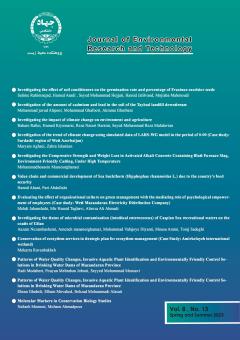-
-
-
Open Access Article
1 - Quantity and quality investigation of generated wastes at steel industries
Zahra Zamiraei علی ناهدRegarding to the variety of uses of steel in the world and widening its scope of application with the advancement of technology, steel production has changed to keep pace with advances in technology, following the changes; producers have tried to raise productivity and MoreRegarding to the variety of uses of steel in the world and widening its scope of application with the advancement of technology, steel production has changed to keep pace with advances in technology, following the changes; producers have tried to raise productivity and use of cheaper energy and fuels due to its geographical environment. There are the wastes in different stages of steelmaking (coke making, iron making and steelmaking). The generated wastes in this industry are with hazardous substances such as heavy metals, according to the classifications of the wastes, are classified as hazardous wastes. Therefore, identification and analysis and management of such waste in these industries are essential. The release of aforesaid hazardous wastes in nature can be had issues and problems for the environment and human health ultimately exceed the acceptable environmental conditions. The proper management of hazardous wastes in order to reduce and control pollution of the environment is utmost importance. Manuscript profile -
Open Access Article
2 - Waste Management of Petrochemical Industries and Its Management
زهرا ضمیرایی علی ناهدNatural gas and crude distillates such as naphtha from petroleum refining are used as feedstocks to manufacture a wide range of petrochemicals that are in turn used in the manufacture of consumer goods. Petrochemical plants are typically l MoreNatural gas and crude distillates such as naphtha from petroleum refining are used as feedstocks to manufacture a wide range of petrochemicals that are in turn used in the manufacture of consumer goods. Petrochemical plants are typically large and complex, and the combination and sequence of products manufactured are often unique to the plant. Petrochemical plants generate significant amounts of solid wastes and sludges, some of which are hazardous because of the presence of toxic organics and heavy metals. A good practice target for a petrochemical complex is to reduce total organic emissions (including VOCs) from the process units to 0.6% of the throughput. In this paper a variety of control of air emissions techniques is has been studied. Petrochemical waste waters often require a combination of treatment methods to remove oil and other contaminants before discharge. For solid and hazardous wastes, combustion (preceded in some cases by solvent extraction) of toxic organics is considered an effective treatment technology for petrochemical organic wastes. Steam stripping and oxidation are also used for treating organic waste streams. The generation of sludges should be minimized. Wastes containing toxic metals should be stabilized before disposal. Manuscript profile -
Open Access Article
3 - Investigation and identification of waste in industrial zone of Guilan province (Case study: Plastic and synthetic rubber industries)
Zahra Zamiraei sadaf feyzi Mohammad panahandehIndustrial development and rapid population growth due to the increase in consumed materials and the consequent increase in industrial waste is one of the challenges in the world. The purpose of this study is to investigate the quantity of industrial waste production in MoreIndustrial development and rapid population growth due to the increase in consumed materials and the consequent increase in industrial waste is one of the challenges in the world. The purpose of this study is to investigate the quantity of industrial waste production in the industrial group of plastics and synthetic rubber in Guilan province and the conditions of resulting pollution. The results of this study show that the major industrial wastes identified in this group include plastic waste, paint cans, cardboard waste, paint powder, packaging strap, polymer waste, polymer sludge, wood waste, glass and carbon fiber waste. Plastic waste with 136.08 tons is the highest and paint powder with 0.04 tons is the lowest industrial waste produced in this group. The used oil with a total amount of 14092 liters per year is the only hazardous waste identified in this group. From the present study, it is concluded that the main management methods used in this industrial group are recycling and sales, but hazardous waste is not disposed of properly. The proposed method for used oil is refining. Manuscript profile -
Open Access Article
4 - Removal of petroleum from contaminated water by affordable adsorbents
Zahra ZamiraeiPetroleum pollution has an important impact on marine plants and animals, coral islands, fishing, beaches, human health and tourism industry. Therefore, it is important to recycle or prevent leakage and to remove them from contaminated water. There are various ways to r MorePetroleum pollution has an important impact on marine plants and animals, coral islands, fishing, beaches, human health and tourism industry. Therefore, it is important to recycle or prevent leakage and to remove them from contaminated water. There are various ways to remove and recycle oil; including physical, mechanical, biological and photochemical methods, filtration and the most widely used way is absorption methods. The choice of an economically suitable hydrophobic absorber should be easy to handle, not expensive, and not be classified as hazardous. The adsorbent material can be organic or inorganic. Organic materials usually include plants, animals, or other high-carbon compounds (such as food waste, rice husk, macroalgae, algae, creatine, etc.). It is also possible to use organic compounds produced in industries such as petroleum and fertilizer industries. Inorganic compounds used as adsorbents are usually substances such as: soil, clay, mud, zeolite, minerals, metal oxides and hydroxides. Manuscript profile
List of Articles Zahra Zamiraei
-
The rights to this website are owned by the Raimag Press Management System.
Copyright © 2017-2024


